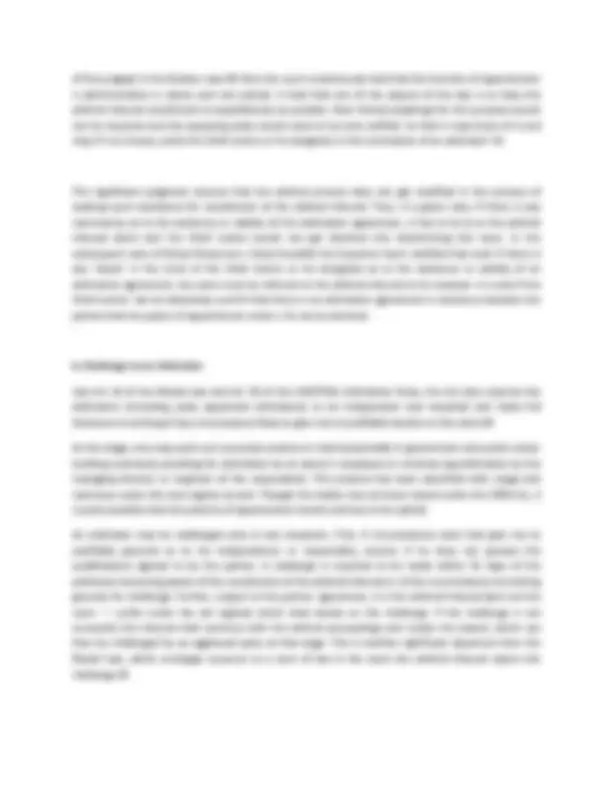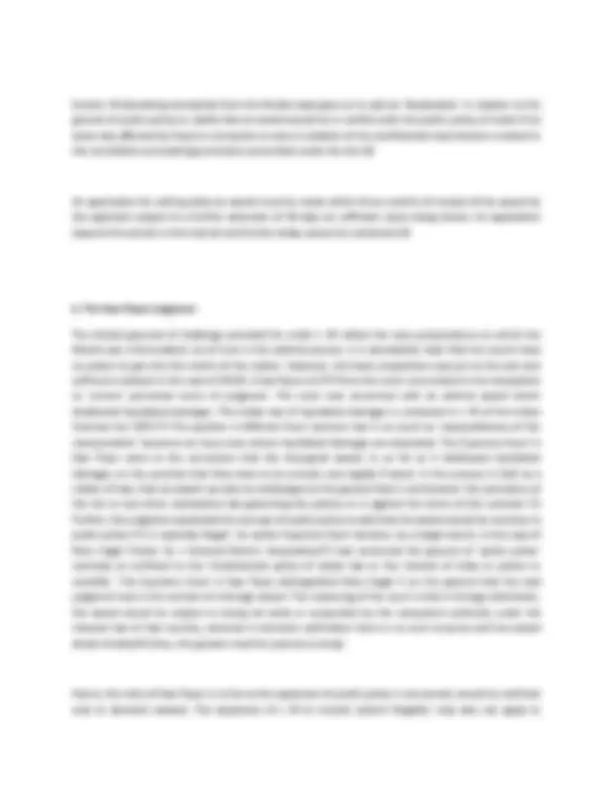

















Study with the several resources on Docsity

Earn points by helping other students or get them with a premium plan


Prepare for your exams
Study with the several resources on Docsity

Earn points to download
Earn points by helping other students or get them with a premium plan
Community
Ask the community for help and clear up your study doubts
Discover the best universities in your country according to Docsity users
Free resources
Download our free guides on studying techniques, anxiety management strategies, and thesis advice from Docsity tutors
Critical analysis of Arbitration law in India
Typology: Essays (university)
1 / 23

This page cannot be seen from the preview
Don't miss anything!
















by Sumeet Kachwaha*
[This article was first published in Asia International Arbitrational Journal, Volume 1, Number 2, Pages 105-126]
India opened a fresh chapter in its arbitration laws in 1996 when it enacted the Arbitration and Conciliation Act (‘the Act’ or ‘new Act’). This article presents salient features of the Act and analyses its workings in its near one decade of existence.
A. The Pre-1996 Position
Prior to 1996, the arbitration law of the country was governed by a 1940 Act. This Act was largely premised on mistrust of the arbitral process and afforded multiple opportunities to litigants to approach the court for intervention. Coupled with a sluggish judicial system, this led to delays rendering arbitrations inefficient and unattractive. A telling comment on the working of the old Act can be found in a 1981 judgment of the Supreme Court where the judge (Justice DA Desai) in anguish remarked ‘the way in which the proceedings under the (1940) Act are conducted and without an exception challenged in Courts, has made lawyers laugh and legal philosophers weep …’.
B. A New Act, A New Beginning
India (in the good company of several other nations) enacted its new Arbitration Act based on the United Nations Commission on International Trade Law Model Law on International Commercial Arbitration2 and the Arbitration Rules of the United Nations Commission on International Trade Law 1976.3 This was in January 1996. The Statement of Objects and Reasons to the Act made no bones of the inefficiency of the old legislation. It said that the same had ‘become outdated’ and there was need to have an Act ‘more responsive to contemporary requirements’. It added: ‘Our economic reforms may not become fully effective if the law dealing with settlement of both domestic and international commercial disputes remains out of tune.’
Amongst the main objectives of the new Act (set out in the Statement of Objects and Reasons) are ‘to minimize the supervisory role of courts in the arbitral process’ and ‘to provide that every final arbitral award is enforced in the same manner as if it were a decree of the Court’.
This is how the Supreme Court dwelled on the new Act:
To attract the confidence of International Mercantile community and the growing volume of India’s trade and commercial relationship with the rest of the world after the new liberalization policy of the
Government, Indian Parliament was persuaded to enact the Arbitration & Conciliation Act of 1996 in UNCITRAL model and therefore in interpreting any provisions of the 1996 Act Courts must not ignore the objects and purpose of the enactment of 1996. A bare comparison of different provisions of the Arbitration Act of 1940 with the provisions of Arbitration & Conciliation Act, 1996 would unequivocally indicate that 1996 Act limits intervention of Court with an arbitral process to the minimum.
C. The Scheme of the Act
The Act is a composite piece of legislation. It provides for domestic arbitration, international commercial arbitration, enforcement of foreign award and conciliation (the latter being based on the UNCITRAL Conciliation Rules of 1980).
The more significant provisions of the Act are to be found in Parts I and II thereof. Part I contains the provisions for domestic and international commercial arbitration. Any arbitration to be conducted in India would be governed by Part I, irrespective of the nationalities of the parties. Part II provides for enforcement of foreign awards.
Part I is more comprehensive and contains extensive provisions based on the Model Law. It provides, inter alia, for arbitrability of disputes, nonintervention by courts, composition of the arbitral tribunal, jurisdiction of the arbitral tribunal, conduct of the arbitration proceedings, recourse against arbitral awards and enforcement. Part II, on the other hand, is largely restricted to enforcement of foreign awards governed by the Convention on the Recognition and Enforcement of Foreign Arbitral Awards5 or the Convention on the Execution of Foreign Arbitral Awards.6 Part II is thus, (by its very nature) not a complete code. This led to judicial innovation by the Supreme Court in the case of Bhatia International v Bulk Trading.7 Here the Indian court’s jurisdiction was invoked by a party seeking interim measures of protection in relation to an arbitration under the Rules of Arbitration of the International Chamber of Commerce International Court of Arbitration8 to be conducted in Paris. The provision for interim measure (s 9) was to be found in Part I alone (which applies only to domestic arbitration). Hence, the court was faced with a situation where there was no proprio vigore legal provision under which it could grant interim measures of protection. Creatively interpreting the Act, the Supreme Court held that the ‘general provisions’ of Part I would apply also to offshore arbitrations, unless the parties expressly or impliedly exclude applicability of the same. Hence, by judicial innovation, the Supreme Court extended the general provisions of Part I to foreign arbitrations as well.
It may be stated that this was premised on the assumption that the Indian courts would otherwise have jurisdiction in relation to the matter (in the international sense). This became clear in a subsequent decision of the Supreme Court in Shreejee Traco (I) Pvt Ltd v Paperline International Inc.9 Here the
under contract, yet there was a sufficiently close connection between that claim and the transaction to bring the claim within the arbitration clause. Citing this, the court in Renu Sagar I continued:
this authority clearly shows that even though a claim may not directly arise under the contract which contains an arbitration clause, if there was sufficient close connection between that claim and the transaction under the contract, it will be covered by the arbitration clause.
Hence, whether an action lies in tort or contract, it would lie before an arbitral forum, unless it can be demonstrated that the cause of action is de hors the contract which contains the arbitration clause.
A controversy arose as to whether arbitrators would have jurisdiction to order specific performance of a contract. The High Court of Delhi held16 that the power to grant specific performance is discretionary and statutorily conferred on civil courts under the Specific Relief Act 1963. Hence, an arbitral tribunal would have no such power. On the other hand, the High Courts of Punjab, Bombay and Calcutta17 took the view that arbitrators could grant specific performance. The Supreme Court put to rest the controversy in Olympus Superstructures Pvt Ltd v Meena Vij ay Khetan18 and held that arbitrators do have the power to order specific performance of a contract. The court relied on Halsbury’s Laws of England19 which states that the differences or disputes which may be referred must consist of ‘a justifiable issue triable civilly. A fair test of this is whether the difference can be compromised lawfully by way of accord and satisfaction.’
In the case of Hindustan Petroleum Corporation v Pink City,20 the respondent resisted arbitration on the ground that the cause of action made out by the claimant (ie short delivery and tampering with weights and measures and seals) was essentially a criminal offence under special statutes. It was contended that the respondent’s conduct could be investigated only by officers so authorised under statute and that the offence, if any, can be tried only by a court of competent jurisdiction and not by an arbitrator. The Supreme Court negatived this contention, holding that the claimant had rights under the contract which are independent of the statutory provisions and hence the contractual rights could be enforced through the arbitration process: ‘The existence of dual procedure; one under the criminal law and the other under the contractual law is a well-accepted legal phenomenon in Indian jurisprudence.’
The Supreme Court has, however, held that a claim for winding up22 is not arbitrable and hence a court action for winding up cannot be dismissed on a contention that the parties had entered into an arbitration agreement.
The case of Man Roland v Multicolour Offset23 made a significant inroad into the sanctity of an arbitration agreement. Here the Supreme Court held that the Monopolies and Restrictive Trade Practices Commission of India (‘Commission’) would have jurisdiction to entertain a claim for damages arising out of an alleged ‘unfair trade practice’ (in this case, sale of alleged defective goods and deficiency in services). The contract between the parties contained an arbitration agreement providing for arbitration in Paris, under ICC Rules with German law applying. The Supreme Court held that the Monopolistic and Restrictive Trade Practices Act 1969 (‘MRTP Act’) provides for statutory remedies in respect of statutorily defined offences and these remedies are in addition to the usual remedies available to the parties under the Contract Act. Hence, the complaint for damages under the MRTP Act would be maintainable despite an arbitration agreement between the parties. This case assumes significance, for an ‘unfair trade practice’ is defined rather widely under the MRTP Act. It includes any ‘unfair or deceptive practice’ for sale of goods or services. The Indian claimant here was thus able to bypass the arbitration agreement and sue for damages in India (with Indian law applying) by adapting the MRTP route.
3. Expert Determination Distinguished from Arbitration
The Supreme Court had occasion to consider this extensively in the case of KK Modi v KN Modi24 where, after citing Mustill & Boyd’s Commercial Arbitration25 and Russell on Arbitration,26 it concluded that, by and large, there were no conclusive tests one could follow to determine whether the agreement was to refer an issue to an expert or whether the parties had in fact agreed to resolve disputes through arbitration. It held:
therefore our courts have laid emphasis on (1) existence of disputes as against intention to avoid future disputes; (2) the tribunal or forum so chosen is intended to act judicially after taking into account relevant evidence before it and the submissions made by the parties before it; and (3) the decision is intended to bind the parties. Nomenclature used by the parties may not be conclusive. One must examine the true intent and purport of the agreement.
As mentioned earlier, the Act governs both domestic and international commercial arbitrations through Part I. There are only two situations where Part I treats domestic arbitration differently from international commercial arbitration. One is in relation to an appointment of an arbitrator by the court and the other is in relation to the determination of governing law (and these are discussed below).
obtained an antiarbitration injunction from the High Court on the ground that the pledge of shares which was sought to be enforced through arbitration would enable the claimants to take control of a telecom company which (as it was a foreign company) would be contrary to Indian law. On appeal, the Supreme Court rejected this contention, stating that this was a plea on merits and thus within the sole jurisdiction of the arbitrators. Interestingly, the court not only vacated the injunction, it also restrained the respondent from moving any further applications ‘which would have the effect of interfering with the continuance and conclusion of the arbitration proceedings’.31 In Sukanaya Holdings v Jayesh Pandya,32 however, the Supreme Court refused to stay the court action on the ground that the subject matter of the arbitration agreement was not the same as the subject matter of the civil suit. Besides, the parties in the two actions were not identical. The court held that the entire subject matter of the suit should be the subject matter of the arbitration agreement in order for the mandatory provisions of s 8 to apply.
6. Interim Measures of Protection
A party which seeks interim measures has essentially two avenues open to it. It can approach the court or it can approach the arbitral tribunal. Section 9 enables a party to approach a competent court before or during the arbitral proceedings or even after the award is pronounced, but before it is enforced. The Model Law in fact has a more restrictive provision: it does not contemplate recourse to a court for an interim measure after the award is pronounced (Art 9).
The Supreme Court in the case of Sundaram Finance v NEPC34 held that if a court is approached before the arbitral proceedings are commenced, the applicant must issue a notice to the opposing party invoking the arbitration clause or, alternatively, the court would have to be first satisfied that the applicant will indeed take effective steps to commence the arbitral proceedings without delay. Further, the court would have to be satisfied that there exists a valid arbitration agreement between the parties.
The arbitral tribunal also has powers to make an order for any interim measure of protection or to provide appropriate security in connection with the measures ordered (s 17). However, this provision is perceived to be ineffective and usually not resorted to. This is for several reasons. Firstly, the applicant has to wait for the arbitral tribunal to be constituted (thus ruling out this route in the case of urgency). Further, there are no sanctions if the order is disobeyed. From a practical viewpoint also, third parties cannot be affected. Further, any interim measure would come to an end with the making of an award (unlike a court obtained order which can continue till enforcement).
Commenting upon the inherent limitations of the provision, the Supreme Court in MD Army Welfare Housing Organisation v Sumangal Services36 stated:
the power of the arbitrator is a limited one. He cannot issue any direction which would go beyond the reference or the arbitration agreement. An interim order must relate to the protection of the subject- matter of dispute and the order may be addressed only to a party to the arbitration. It cannot be addressed to other parties … no power is conferred upon the Arbitral Tribunal to enforce its order nor does it provide for judicial enforcement thereof.
It may be mentioned that orders passed under ss 9 and 17 are appealable.
7. Arbitrators
a. Appointment of Arbitrators
The Act allows full freedom to the parties in the matter of appointment of arbitrators. However, if there is a failure of the parties’ agreed mechanism for appointment, the Chief Justice of a High Court (in the case of a domestic arbitration) or the Chief Justice of the Supreme Court of India (in the case of an international commercial arbitration) may be approached for this purpose. This is the first instance in which the Act envisages recourse to a court in relation to arbitration proceedings.
The Act demonstrates its sensitivity towards a foreign litigant embroiled in an arbitration in India. Thus, while parties to a domestic dispute have to approach the Chief Justice of the High Court of the state, the parties in an international commercial arbitration would be able to approach the highest judicial officer of the country, viz, the Chief Justice of India. (In contrast, the Model Law envisages the appointment to be made by a court.38) Commenting on the mandate resting on the highest judicial officer of the land, the Supreme Court in Konkan Railway Corporation v Rani Construction Pvt Ltd39 commented:
The function has been le to the Chief Justice or his designate advisedly, with a view to ensure that the nomination of the arbitrator is made by a person occupying high judicial office or his designate, who would take due care to see that a competent, independent and impartial arbitrator is nominated.
A question arose as to whether the Chief Justice is required to carry out his duty (of appointment) in an administrative or in a judicial capacity. If the Chief Justice is required to act in a judicial capacity, a certain procedure would have to be followed which would necessarily entail delays and the decision may tend to embarrass the arbitrator’s jurisdiction to decide issues of merit or jurisdiction independently. There may also be a possibility of conflicting decisions. After some difference of opinion, the controversy was finally se led by a Constitution Bench of the Supreme Court (ie a bench comprising
The Indian courts have held that ‘the apprehension of bias must be judged from a healthy, reasonable and average point of view and not on mere apprehension of any whimsical person. Vague suspicions of whimsical, capricious and unreasonable people are not our standard to regulate our vision.’
c. Termination of Mandate of an Arbitrator
The Act provides that the mandate of an arbitrator shall terminate in two circumstances: (1) if he becomes de jure or de facto unable to perform his functions; or (2) if he fails to act without undue delay. If there is any controversy as to the above, a party may, unless otherwise agreed, apply to the court for a decision (the second instance of court intervention envisaged by the Act).
8. Jurisdiction of the Arbitral Tribunal
Section 16 of the Act (corresponding to Art 16 of the Model Law) is a key provision of the Act. The section provides that the arbitral tribunal may rule on its own jurisdiction, including with respect to the existence or validity of the arbitration agreement. Further, the arbitration clause shall be treated as independent of the underlying contract and a decision that the contract is null and void shall not entail ipso jure the invalidity of the arbitration clause. Where the arbitral tribunal rejects an objection to its jurisdiction, it shall continue with the arbitral proceedings and make the award. Any challenge to the award would be available at that stage. If, on the other hand, the arbitral tribunal accepts the plea as to its lack of jurisdiction, an appeal shall lie to a court of law.
This again marks a significant departure from the Model Law which contemplates recourse to a court from a decision of the arbitral tribunal rejecting a challenge to its jurisdiction. The Indian legislature’s keenness to keep the courts out of the arbitral process thus becomes evident with every step of the legislation.
9. Arbitral proceedings
a. Conduct of Arbitral Proceedings
The arbitrators are masters of their own procedure and subject to parties’ agreement, may conduct the proceedings ‘in the manner they consider appropriate’. This power includes the power to determine the admissibility, relevance, materiality and weight of any evidence.48 The only restraint on them is that they shall treat the parties with equality and each party shall be given a full opportunity to present his case,49 which includes sufficient advance notice of any hearing or meeting.50 Neither the Code of Civil
Procedure 1908 (‘CCP’) nor the Indian Evidence Act 1872 apply to arbitrations.51 Unless the parties agree otherwise, the tribunal shall decide whether to hold oral hearings for the presentation of evidence or for arguments or whether the proceedings shall be conducted on the basis of documents or other material alone. However, the arbitral tribunal shall hold oral hearings if a party so requests (unless the parties have agreed that no oral hearing shall be held).
The arbitrators have power to proceed ex parte where the respondent, without sufficient cause, fails to communicate his statement of defence or appear for an oral hearing or produce evidence. However, in such a situation the tribunal shall not treat the failure as an admission of the allegations by the respondent and shall decide the matter on the evidence, if any, before it. If the claimant fails to communicate his statement of claim, the arbitral tribunal shall be entitled to terminate the proceedings.
b. Taking of Evidence in Arbitral Proceedings
The Indian Oaths Act 1969 extends to persons who may be authorised by consent of parties to receive evidence. This Act, thus, encompasses arbitral proceedings as well.54 Section 8 of the said Act states that every person giving evidence before any person authorised to administer oaths ‘shall be bound to state the truth on such subject’. Thus, witnesses appearing before an arbitral tribunal can be duly sworn by the tribunal and be required to state the truth on oath and upon failure to do so, commit offences punishable under the Indian Penal Code.55 However, the arbitrators cannot force unwilling witnesses to appear before them and for this the court’s assistance is provided vide s 27 of the Act. Under this provision the arbitral tribunal or a party with the approval of the tribunal may apply to the court seeking its assistance in taking evidence (this is also provided for in the Model Law). However, s 27 of the Act goes beyond the Model Law as it states that any person failing to attend in accordance with any order of the court or making any other default or refusing to give evidence or guilty of any contempt of the arbitral tribunal, shall be subject to like penalties and punishment as he may incur for like offences in suits tried before the court. Further, the court may either appoint a commissioner for taking evidence or order that the evidence be provided directly to the arbitral tribunal. These provisions extend to any documents to be produced or property to be inspected. Section 26 provides for appointment of experts by the arbitral tribunal for any specific issue. In such a situation, a party may be required to give the expert any relevant information or produce any relevant document, goods or property for inspection as may be required. It will be open to a party (or to the arbitral tribunal) to require the expert, after delivery of his report, to participate in an oral hearing where the parties would have an opportunity to put questions to him.
Interpretation of a contract is an issue of law and also within the sole prerogative of an arbitrator:
When the arbitrator is required to construe a contract then merely because another view may be possible the court would not be justified in construing the contract in a different manner and then to set aside the award by observing that the arbitrator has exceeded his jurisdiction in making the award.
The court by purporting to construe the contract cannot take upon itself the burden of saying that the construction was contrary to the contract and as such beyond jurisdiction.63 However, in construction contracts if there is no provision for escalation or for additional quantity of work, the arbitrator cannot allow the same.
The arbitrator is bound to state the reasons for the award unless the parties have agreed otherwise or the award is on agreed terms (as a result of a settlement). An award, however, cannot be challenged for lack of adequate reasons65 (or indeed the reasonableness of the reasons66).
The arbitral tribunal is empowered to make typographical or clerical corrections to the award either on its own initiative or on an application of the parties.
The tribunal may at any time during the arbitral proceedings make an interim award on any matter with respect to which it may make a final award.
12. Arbitral Awards
a. Recourse against Awards
A domestic award can be challenged and set aside only by way of an application under s 34 of the Act and only on the grounds contained thereunder. Section 34 is based on Art 34 of the Model Law. To paraphrase the provision, an award can be set aside if: (1) the party making the application was under some incapacity; or (2) the arbitration agreement was not valid under the law agreed to by the parties (or applicable law); or (3) the party making the application was not given proper notice of the appointment of the arbitrator or of the arbitral proceedings or was otherwise unable to present his case; or (4) the award deals with a dispute not contemplated by or falling within the terms of submissions to arbitration or it contains decisions beyond the scope of the submissions to arbitration; or (5) the composition of the arbitral tribunal or the arbitral procedure was not in accordance with the agreement of the parties; or (6) the subject matter of the dispute was not capable of settlement by arbitration; or (7) the arbitral award is in conflict with the public policy of India.
Section 34 (deviating somewhat from the Model Law) goes on to add an ‘Explanation’ in relation to the ground of public policy to clarify that an award would be in conflict with the public policy of India if the same was affected by fraud or corruption or was in violation of the confidential requirements a ached to the conciliation proceedings provisions prescribed under the Act.
An application for setting aside an award must be made within three months of receipt of the award by the applicant subject to a further extension of 30 days on sufficient cause being shown. An application beyond this period is time barred and further delay cannot be condoned.
b. The Saw Pipes Judgment
The limited grounds of challenge provided for under s 34 reflect the very jurisprudence on which the Model Law is formulated, viz of trust in the arbitral process. It is abundantly clear that the courts have no power to get into the merits of the matter. However, this basic proposition was put to the test and suffered a setback in the case of ONGC v Saw Pipes Ltd.70 There the court succumbed to the temptation to ‘correct’ perceived errors of judgment. The court was concerned with an arbitral award which disallowed liquidated damages. The Indian law of liquidated damages is contained in s 74 of the Indian Contract Act 1872.71 The position is different from common law in as much as ‘reasonableness of the compensation’ becomes an issue even where liquidated damages are stipulated. The Supreme Court in Saw Pipes came to the conclusion that the impugned award, in so far as it disallowed liquidated damages on the premise that they have to be proved, was legally fl awed. In the process it held as a matter of law, that an award can also be challenged on the ground that it contravenes ‘the provisions of the Act or any other substantive law governing the parties or is against the terms of the contract’. Further, the judgment expanded the concept of public policy to add that the award would be contrary to public policy if it is ‘patently illegal’. An earlier Supreme Court decision, by a larger bench, in the case of Renu Sagar Power Co v General Electric Corporation73 had construed the ground of ‘public policy’ narrowly as confined to the ‘fundamental policy of Indian law or the interest of India or justice or morality’. The Supreme Court in Saw Pipes distinguished Renu Sagar II on the ground that the said judgment was in the context of a foreign award. The reasoning of the court is that in foreign arbitration, the award would be subject to being set aside or suspended by the competent authority under the relevant law of that country, whereas in domestic arbitration there is no such recourse and the award attains finality74 (thus, the greater need for judicial scrutiny).
Hence, the ratio of Saw Pipes in so far as the expansion of public policy is concerned, would be confined only to domestic awards. The expansion of s 34 to include ‘patent illegality’ may also not apply to
For the purposes of this article, we deal with the provisions relating to the New York Convention alone (since the provisions pertaining to the Geneva Convention are now otiose).
a. Definition of Foreign Award
This is contained in s 44 of the Act. A peculiar feature of Indian law is that a foreign award by definition means an award passed in such territory as the Central Government by notification may declare to be a territory to which the New York Convention applies. Hence, even if a country is a signatory to the New York Convention, it does not ipso facto mean that an award passed in such country would be enforceable in India. There has to be further notification by the Central Government declaring that country to be a territory to which the New York Convention applies.
The reservation carved out by the Indian legislation (though in terms of and permitted by the New York Convention) may well prove to be a legal trap for the unwary. Only 43 countries have been notified so far by the Indian government. Thus, while France, Germany, United Kingdom, United States of America, Japan and Singapore have been notified; Hong Kong and Australia (amongst many others) have not yet been notified.
14. Reference of Parties to Arbitration
Section 45 of the Act provides that notwithstanding anything contained in the CCP, a judicial authority when seized of an action in respect of a matter where the parties have entered into an arbitration agreement shall, at the request of any party, refer the parties to arbitration. The only exception is if the court finds the agreement to be null and void, inoperative or incapable of being performed. It would be noticed that this section (though in tune with Art 8 of the Model Law) is a little different from its corresponding provision in the Act for domestic arbitrations (s 8) in as much as it permits a court to retain jurisdiction on the ground that the arbitration agreement is null and void, inoperative or incapable of being performed. So while these contentions would not furnish grounds for avoiding the arbitral process in a domestic arbitration, the position in relation to foreign arbitrations would be different. This difference in the Act between Indian and foreign arbitrations is possibly premised on the fact that it may be too harsh to compel an Indian party to undergo arbitration in a foreign country if it could demonstrate that the arbitration agreement is null and void, inoperative or incapable of being performed (and in any case the Model Law also envisages court intervention to this extent).
An interesting issue arose in Shin-Etsu Chemical Co Ltd v Aksh Optifibre Ltd77 as to whether a ruling by the court on the validity or otherwise of an arbitration agreement is to be on a prima facie basis or a final decision. If it were to be a final decision, it would involve a full trial and consequently years and years of judicial proceedings which would frustrate the arbitration agreement. Keeping this and the object of the Act in mind, the Supreme Court, by a 2:1 decision, held that a challenge to the arbitration agreement under s 45 on the ground that it is ‘null and void, inoperative or incapable of being performed’ is to be determined on a prima facie basis. It said:
If it were to be held that the finding of the court under Section 45 should be a final, determinative conclusion, then it is obvious that, until such a pronouncement is made, the arbitral proceedings would have to be in limbo. This evidently defeats the credo and ethos of the Act, which is to enable expeditious arbitration without avoidable intervention by judicial authorities.
This would mean that a court decision under s 45 would not operate as res judicata and the aggrieved party would be able to challenge the same in subsequent proceedings. Thus, in effect, a person challenging an arbitration agreement on the ground that it is null and void, inoperative or incapable of being performed would have three rounds to vent his grievances: the first, under s 45 before an Indian court; the second time around before the arbitral tribunal itself; and, finally, at the stage of enforcement of the arbitral award. The judgment of the Supreme Court is no doubt welcome. Any other interpretation would have brought about a situation where it would take very little for a dishonest litigant to derail a foreign arbitration. At the same time an issue would remain as to what is to be done in cases where the court does in fact come to a conclusion that the arbitral agreement is null and void, inoperative or incapable of being performed. A decision to this effect is appealable under s 50 of the Act. Thus, a ruling on a prima facie view alone would not be satisfactory. One of the judges addressed this and held that if the court were to arrive at a prima facie conclusion that the agreement is in fact null and void, it would go ahead and hold a full trial and enter a final verdict. In such a situation, therefore, a foreign arbitration may well come to a halt pending final decision from an Indian court, but otherwise proceedings under s 45 would not have any significant effect impeding progress of a foreign arbitration.
15. Conditions for Enforcement of Foreign Award
Where the court78 is satisfied that a foreign award is enforceable, it shall be deemed to be a decree of that court.79 Grounds for refusal of enforcement are provided for under s 48 of the Act and these are virtually the same as the New York Convention grounds (and, therefore, not markedly different from the Model Law). There are two noteworthy differences between ss 48 and 34. Section 34 (in relation to domestic awards) permits the court to set aside an award; whereas s 48 provides only for refusal to enforce a foreign award. (Refusal to enforce an award would not therefore by itself prevent an applicant from seeking to enforce it in some other jurisdiction.) There is no provision in Indian law for setting aside
retrogressive step. However, it is hoped that when the opportune moment arrives, the decision will be reviewed.
India has an effective law in place. What it now needs is inculcation of the culture of arbitration within the bar, the bench and the arbitral community. The baggage of the past needs to be dropped so that India, indeed, has an attractive arbitration mechanism on offer.
1 Guru Nanak Foundation v Ra an Singh & Sons 1981 (4) SCC 634.
2 General Assembly Resolution 40/72, adopted on 11 December 1985 (‘Model Law’).
3 General Assembly Resolution 31/98, adopted on 15 December 1976 (‘UNCITRAL Arbitration Rules’).
4 Konkan Railway Corporation v Mehul Construction Co 2000 (7) SCC 201.
5 New York, 10 June 1958 (‘New York Convention’).
6 Geneva, 26 September 1927 (‘Geneva Convention’).
7 2002 (4) SCC 105 (‘Bhatia’).
8 Effective 1 January 1998 (‘ICC Rules’).
9 2003 (9) SCC 79.
10 Supra, n 7.
11 ‘This Part shall not affect any other law for the time being in force by virtue of which certain disputes may not be submitted to arbitration’: the Act s 2(3).
12 Smita Conductors Ltd v Euro Alloys Ltd 2001 (7) SCC 728.
13 Section 7.
14 1984 (4) SCC 679 (‘Renu Sagar I’).
15 [1947] 2 All ER 260.
16 Sulochana Uppal v Surinder Sheel Bhakri AIR 1991 Del 138.
17 Lakshmi Narain v Raghbir Singh AIR 1956 Punj 249; Fertiliser Corp of India v Chemical Construction Corp ILR 1974 Bom 856 (DB); Keventer Agro Ltd v Seegram Comp Ltd, Apo 498 of 1997 dated 27 January 1998 (Cal).
18 1999 (5) SCC 651.
19 Fourth Edition, Bu erworths (Arbitration, Vol 2, para 503).
20 2003 (6) SCC 503.
21 Ibid at 515.
22 Haryana Telecom v Sterlite Industries 1999 (5) SCC 688.
23 2004 (7) SCC 447.
24 1998 (3) SCC 573.
25 Second Edition, 1989, Butterworths.
26 Twenty-first Edition, 1997, Sweet & Maxwell.
27 Supra, n 24 at 585.
28 A somewhat confusing expression borrowed from taxing statutes.
29 Section 2(f).
30 2003 (12) SCC 140.
31 Id at 144.
32 2003 (5) SCC 531.
33 ‘Court’ is defined vide s 2(e) to mean the principal civil court of original jurisdiction, having jurisdiction to decide the question forming the subject matter of the arbitration (if the same had been the subject matter of a suit). This would thus mean either the District Court or the High Court of a state (as in some states, High Courts have original civil jurisdiction beyond a certain pecuniary limit).
34 1999 (2) SCC 479.
35 Id at 488.
36 2004 (9) SCC 619.
37 Section 37.
38 Model Law, Arts 6 and 11.
39 2002 (2) SCC 388 at 405.
40 Ie Konkan Railway Corporation v Rani Construction Pvt Ltd 2002 (2) SCC 388.
41 Id at 406.
42 2000 (7) SCC 497.